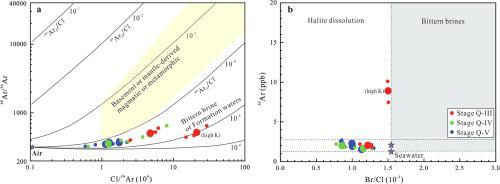Ore Geology Reviews ( IF 3.2 ) Pub Date : 2021-01-23 , DOI: 10.1016/j.oregeorev.2021.104011 Pei Liang , Richen Zhong , Liandang Zhao , Chao Wu , Yuling Xie

|
The Qiaoxiahala deposit is a significant Paleozoic Fe-Cu-Au deposit in the northern margin of East Junggar, NW China, which has been confirmed to form in a basin inversion setting (dying back-arc basin). The composition of noble gases (Ar, Kr, and Xe) and halogens (Cl, Br, and I) extracted from fluid inclusions, hosted in quartz, calcite, and epidote from various mineralization stages of Qiaoxiahala, are investigated to trace the sources of ore fluids and discuss the ore genesis. Significant multistage mineralization at Qiaoxiahala is identified as magnetite mineralization (stage III), magnetite-pyrite mineralization (stage IV), and chalcopyrite mineralization (stage V). Syn-ore fluid inclusions show salinities varying from 13.2 to 15.3 wt% (NaCl eq.) associated with elevated I/Cl ratios (214 × 10−6 to 3950 × 10−6), uniformly low Br/Cl ratios (0.78 × 10−3 to 1.30 × 10−3), and low 40Ar/36Ar ratios (<700). The low 40Ar/36Ar ratios and Br/Cl ratios preclude the involvement of magmatic or metamorphic fluids (high 40Ar/36Ar), and sub-aerial evaporation bittern brines (elevated Br/Cl). The predominance of sedimentary formation water modified by organic-rich sediments is supported by the high I/Cl ratios, low 36Ar concentrations (less than or equal to that of Air Saturated Water, ASW), and the constant 40ArE/Cl slopes (10−5 to 10−4) of fluid inclusions from various mineralization stages in Qiaoxiahala. The elevated δ18Owater values (7.2–11.1‰) of the ore-forming fluids and the common presence of organic matter (e.g. C4H6, C2H2 and CH4) in fluid inclusions further indicated the involvement of organic-rich materials. However, different δDwater values and a significant gap between halogen and noble gas data in stages III and IV-V indicate that different sedimentary formation fluids are involved during these stages, i.e., extensive water-wall rock interactions between seawater and Beitashan Formation in stage III and formation waters formed by diagenesis and compaction in stages IV-V. Multistage mineralization, i.e., Fe-oxide and chalcopyrite (-gold), and the mixing of different non-magmatic fluids with variable origins in Qiaoxiahala are similar to many iron oxide-Cu-Au deposits (IOCGs) from the Central Andes, indicating an IOCG-like type deposit for Qiaoxiahala. These finding further suggest that non-magmatic fluids dominate the formation of IOCG deposits in the basin inversion setting at the northern margin of East Junggar.











































 京公网安备 11010802027423号
京公网安备 11010802027423号